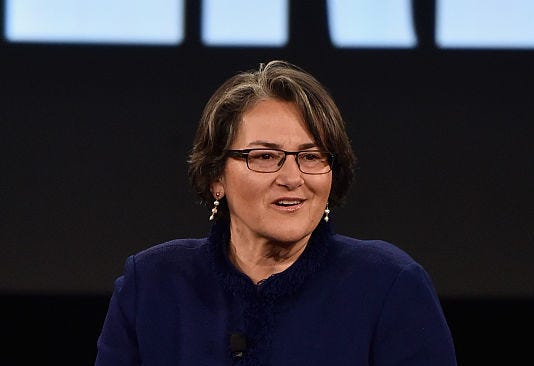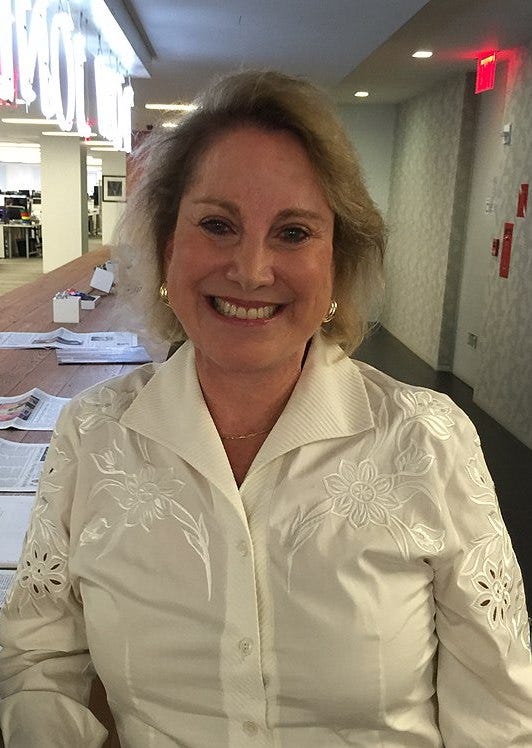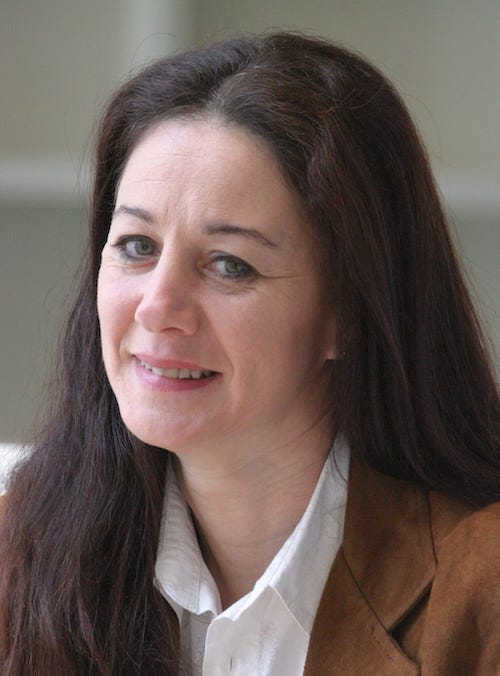
You know, the standard stories from the early days of Silicon Valley.
I thought my presentation had gone pretty well until 24-year-old Verónica slowly raised her hand and said “Ummm, there wasn’t a single woman in your entire presentation.”
<facepalm> I couldn’t believe I had just done that. I just gave a presentation entirely about old white men. <facepalm again>
So for Verónica (and everyone else), I’m now writing this post as a way of beginning to atone for my error.
My presentation mostly covered the formative years of Silicon Valley from 1950–90. Back in those days, the Valley was, without question, a male-dominated culture. Partly, this was because many of the early Silicon Valley companies were driven by military funding (the ultimate boys’ club), partly because engineering schools were churning out graduates who were overwhelmingly white and male, and partly because the cultural norms of the time had boys playing with science kits and girls doing other things.
But the very early days of computing actually featured many women. Famously, the very first programmer was a woman: Ada Lovelace. And Grace Hopper is the most famous female computer scientist of all time, doing the work that led to COBOL (programming language) still in use 60 years later. Early computer companies like IBM actively recruited women, believing they were particularly well suited to be computer users.
But that was all on the East Coast, while here on the Other Coast, in what is now known as Silicon Valley, the focus was on manufacturing things with, well, silicon. Transistors, integrated circuits, and the other building blocks of electronics, all made with silicon.
Here are seven incredibly talented and influential women who played a significant role in shaping the early days of Silicon Valley.

1. Joanna Hoffman
I have a distinct memory of Joanna Hoffman from meeting her at a meeting at Apple in the early 1980s. She stood out for reasons more than just being the only female. An immigrant from Poland, she went to MIT and the University of Chicago before making a trip to Palo Alto, meeting Jef Raskin and Steve Jobs, and ending up as a founding member of the Macintosh team. She quickly became known as the smartest person in any room she entered, and for being able to hold her own in arguments with Steve Jobs. In 1982, she won a satirical award at Apple for being “The person who did the best job standing up to Steve.” When Jobs was fired from Apple in 1985, Hoffman joined the founding team at NeXT, and then in the 1990s, she was on the founding team at General Magic (the most important Silicon Valley company you’ve never heard of).

2. Sandra Kurtzig
The first woman CEO that I was aware of during my career in Silicon Valley was Sandra Kurtzig. She came out of Stanford with a Master’s in aeronautical engineering in 1972, got married, started a family, and did a little freelance programming business out of her extra bedroom just to “keep her mind occupied.” When a client asked her to create an inventory management program for manufacturing, she realized that this could be a product she could sell to other manufacturing companies. So she founded ASK Computer Systems. ASK had an IPO in 1981, making her a multi-millionaire and a major player in the Silicon Valley of the 1980s and 90s. At its peak, Kurtzig’s company had nearly a billion dollars in revenue and 91 offices in 15 countries. She sold it to Computer Associates and went on to found a new startup, Kenandy, named after her two sons, Ken and Andy.

3. Carol Bartz
The hard-driving straight shooter Carol Bartz took over as CEO of Autodesk in 1992. She was incredibly successful, driving them from $300M in revenue to more than $1.5B. At Autodesk, she instituted her “3F” principle, meaning “fail fast forward.” She wanted employees to be risk-taking, but to fail fast and fall forward, creating the innovation-driven culture that is now considered standard throughout Silicon Valley. During her 14 years as CEO, she was known for her no-nonsense approach and her salty language as she drove the company’s stock price at better than 20% per year. Then in 2009, she was recruited away from Autodesk to take the CEO job at Yahoo. People talked of it being a “glass ceiling–shattering event.” And yet just two years later she was fired by Yahoo’s chairman of the board, via phone. “He didn’t even have the balls to meet with me face to face,” she said, adding “the Yahoo board fucked me over.”

4. Donna Dubinsky
You probably carry an iPhone or an Android device in your pocket today, but you may or may not remember the PalmPilot, the device that started the handheld revolution.
The founding CEO was Donna Dubinsky, a Harvard Business School graduate who had come West to join Apple, got in an argument with Steve Jobs, ended up running Apple’s software division, Claris, and then became CEO of Palm and changed the world by launching the world’s first successful handheld computer. All of this was long before the iPhone was a twinkle in Steve Jobs’ eye.
Many of the concepts developed by Palm are still in use in smartphones today, and Donna is now a trustee at the Computer History Museum in Silicon Valley.

5. Sandy Lerner
You’re reading this article right now by virtue of an internet router, and you probably know that Cisco is a $52 billion company built on selling routers.
But you may not know that Cisco was co-founded by Sandy Lerner. She worked at Stanford University and invented the router as part of her efforts to get the computers on campus to talk to each other more efficiently. She and her husband boot-strapped the company for three years, using their own credit cards for financing, and then sold 30% of the company for $2.6 million. The new investors fired her and hired a new outside CEO.
She now lives on a farm in Virginia and is an advocate for animal welfare and women’s writing. When she gives speeches to aspiring entrepreneurs, her advice is always simple: “Do not give control to outside investors.”

6. Diane Greene
At the age of 19, Diane Greene organized the first Windsurfing World Championship. A few years later she created a company that would change Silicon Valley. She co-founded VMware in 1998, as she and her team invented the virtualization software that made possible much of what today we call “cloud computing.” In her 10 years as CEO, she grew the company into what is today a $9 billion operation spanning the globe. From there she went on to run Google’s cloud business and ultimately to the highest perch in Silicon Valley: A seat on Google’s board of directors. Today she is an active startup investor and sits on the boards of Stripe, Wix, and several other leading tech companies.
All of these women did much to build Silicon Valley, and to pave the way for others who followed. There were, of course, thousands of other women who never occupied the CEO suite but did just as much to shape the Valley’s culture and economy. Susan Barnes, who balanced the books at Apple and co-founded NeXT Computer with Steve when he was fired from Apple. Meg Whitman who as CEO of eBay grew the company from $4 million to $8 billion in annual revenue. Ann Winblad, who became one of the first female venture capitalists in Silicon Valley when she founded Hummer Winblad Venture Partners in 1989. Carly Fiorina, who became the first woman CEO of a Fortune 20 company, when she was hired by HP in 1999.
But the biggest single turning point in gender representation in the Valley probably came with the founding of Google, as Larry Page and Sergey Brin hired their first employees with the specific intention of recruiting women onto the team. One of the very first hires was Susan Wojcicki, now CEO of YouTube. Then Sheryl Sandberg, now COO of Facebook, and Marissa Mayer, who would become CEO of Yahoo. Heather Cairns was employee №2 and now is an active angel investor. Joan Braddi was employee №14 and is still there, running Product Partnerships for the company. Larry and Sergey’s explicit intention to create a mixed-gender early team (and the wealth-creation that followed) had a ripple effect throughout the Valley — one that is still rippling today.
We’re at an inflection point now. Women are still underrepresented in Silicon Valley’s halls of power, for sure, but they are far more present than at any time in my career. In my 10 years of teaching entrepreneurship at Stanford, my classes have gone from 10% female to nearly 50%. The number of investment partners at venture capital firms has doubled since 2017, and the big, leading VC firms such as Sequoia, Lightspeed, and Andreessen Horowitz all now have multiple female partners with the power to write checks. The numbers are nowhere near parity yet, but the progress has been substantial in a few short years and the trajectory is clear.

7. Mary Meeker
Today there are very successful women all over Silicon Valley, from Katrina Lake (founded Stitch Fix at the age of 28 is now CEO of $2 billion company) to Christina Stembel of Farmgirl Flowers (turned down by VCs who told her that her slides were “too feminine,” which worked out well for her because now she runs a fast-growing $50M/year business with zero outside investors to worry about).
Mary Meeker, the former analyst for Kleiner Perkins, now runs her own leading venture capital firm, Bond Capital, and publishes the most influential trends report every year. Aileen Lee, who coined the term “unicorn” for billion-dollar startups and founded one of the first female-led venture capital firms. Jess Lee, who at the age of 33 became the first female partner at Sequoia Capital and is deeply committed to investing in underrepresented founders.
So yes, Verónica, you are right. My presentation on Silicon Valley’s formative years was pitifully short on women. But the Silicon Valley of history and today certainly is not short on women.
The astute reader will notice that the women I’ve mentioned above are almost all white. It’s true, sadly; the history of Silicon Valley is filled with males and filled with white. But that too is changing, albeit not fast enough.
Silicon Valley in 2020 has one of the most ethnically diverse metropolitan populations in the world. That population diversity is moving its way into the executive ranks of nearly every company, including many of the top spots. A visitor from 1960 Silicon Valley would be stunned to see the executive diversity at companies today. But the progress has been slow and needs to be accelerated.
The work is not done. There is more work to do. We don’t yet have gender parity, and we don’t yet have a regional economy that genuinely reflects the diversity of our residents. But I believe in the power of entrepreneurship to create an opportunity for all, and I believe that we have crossed a tipping point toward gender equality and diversity in Silicon Valley.
Okay, now I gotta go back to work on updating my slides…







